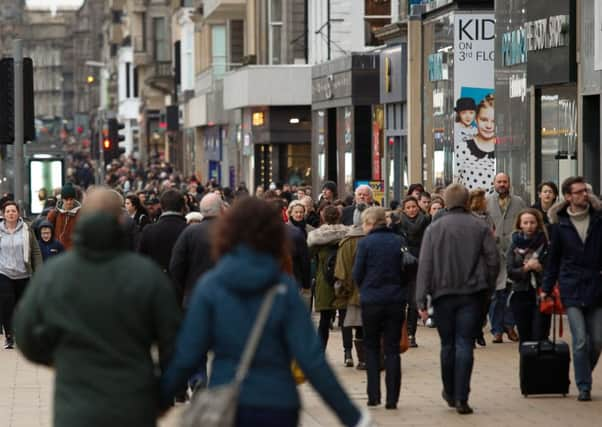Bill Jamieson: The hole in the middle of the election campaign


Labour market numbers have long been regarded as a better indicator of our economic health than GDP statistics – estimates spanning a wide range of data and prone to frequent and significant revision.
Since the recovery gathered pace in 2011, Scotland was able to claim both a lower rate of unemployment and a higher percentage of people in work than the rest of the UK.
Advertisement
Hide AdAdvertisement
Hide AdThe figures helped to underpin confidence despite the ferocity of the campaign claims and counter-claims. But today the figures are not at all so reassuring. Is this just a temporary dip? Or is something more serious afoot?
Unemployment in Scotland rose by 20,000 between December and February to 171,000, according to official figures last week. Our unemployment rate is now 6.2 per cent, higher than the 5.1 per cent rate for the UK as a whole.
Employment fell by 21,000 to stand at 2.61 million, with the rate decreasing to 73.9 per cent, below the UK average of 74.1 per cent.
The job figures are by no means an isolated signal that the economy is losing momentum. Recent figures showed our overall economic performance also diverging from the UK picture, with Scottish GDP growth averaging just 0.1 per cent over the last three-quarters and significantly below that recorded for the UK overall.
Then there was that worrying Bank of Scotland Purchasing Managers Index survey earlier this month showing a sharp deterioration in business conditions in Scotland’s private sector, with output declining and staffing levels continuing to fall. The volume of incoming new business fell for the second successive month, driven by the sustained downturn in the oil and gas industry. The seasonally adjusted headline PMI posted 48.5 in March, falling from February’s 49.2, led by a sharp contraction in the manufacturing sector.
And as if all this was not enough, the latest Scottish Retail Consortium-KPMG data showed total sales for the five weeks to 2 April 1.3 per cent lower than the same period last year.
Last week brought a warning from the Scottish Chambers of Commerce that “our economy is on a knife edge between growth and recession”.
Is it all doom and gloom? By no means. Construction, which helped to keep the Scottish economy out of recession in 2015, performed strongly in the early part of this year and continues to demonstrate positive expectations for the future. Manufacturing experienced a sharp dip, but the Scottish Chambers expect this to recover over the next few months. Visitor numbers and tourism are also holding up relatively well.
Advertisement
Hide AdAdvertisement
Hide AdBut there is a growing realisation that there is more amiss here than the well- documented troubles in the North Sea oil and gas sector. The evidence points to a wider downturn.
And this only highlights the remarkable absence of any serious discussion about the economy in the Holyrood election campaign. This remains sharply focused on competing claims over public spending – the health service, incapacity benefits, welfare provision, pledges to restore cuts in local authority spending and proposals to raise income tax for high earners.
However desirable all these may be, by far the greater benefit to Scottish well-being and prosperity flows from a vibrant economy, with growing investment, business expansion and numbers in work. Yet there is barely discernible attention to this in the election campaign.
Underlying all this is the campaign for a second independence referendum – and this itself could be acting as a brake or disincentive business investment.
It may be that, even with all the extra devolved powers, Scotland’s politicians feel they can do little to alter the macroeconomic picture to any significant degree. This is certainly true. But there is much that can be done at the micro level to help stimulate business activity and investment.
Andy Willox, Scottish policy convener of the Federation of Small Businesses in Scotland, declared last week that the labour market figures “should focus minds for those pounding pavements on the Holyrood campaign trail.
“Our research shows Scottish small business confidence faltering”, with firms facing a raft of new challenges including the National Living Wage and pension auto-enrolment deadlines.
“We need to get behind our army of small businesses and make it as easy as possible for Scottish firms to create jobs and drive local prosperity.”
Advertisement
Hide AdAdvertisement
Hide AdSimilar concerns are expressed by the Scottish Chambers. “Costs to businesses,” it urges, “must also be considered at a time when many firms are implementing the National Living Wage and auto-enrolment. As businesses take on more financial responsibilities over their employees, it is time that the rising burden of business rates was reduced, and this must be one of the key objectives of the forthcoming review of rating in Scotland announced by the Scottish Government.”
Some would argue that we need not worry too much about the travails of the retail sector as the numbers are affected by the growing switch to online shopping. But that is to overlook the effect that physical store closures are having on our high streets and the centres of many towns and villages across Scotland. This requires a deep rethink on future town planning and ways in which our communities can be reconfigured and our town and village centres able to bring people together.
Removing barriers to small traders and enterprises and cutting business rates are essential steps forward in this area. But the trend in business rates seems to be inexorably up – despite the worrying evidence of accelerating closure and decline.
Some recognition of this – and wider issues – is sorely needed in the remaining weeks of the election campaign. Is it too much to hope for?